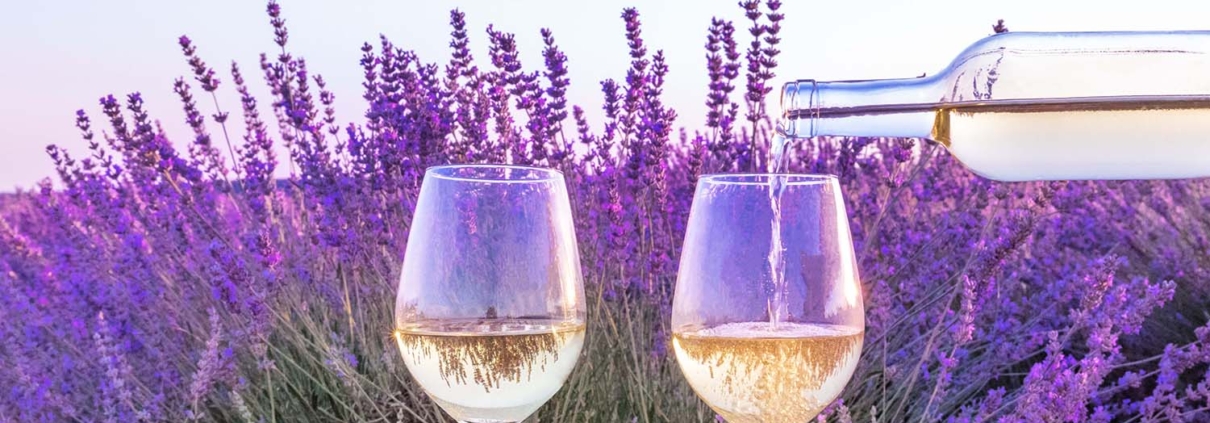The Best Lavender for Mead
Selecting the Perfect Lavender for Your Mead
Imagine a vibrant field of lavender in bloom—a precursor to the delicate flora sweetness of a lavender mead.
Creating a lavender-infused mead can fill your glass with the essence of a summer garden – but choosing the right lavender is key. Not all lavender varieties are suited for culinary use; some taste delightfully sweet and floral, while others can make your mead bitter or soapy. Let’s take a look at a few lavenders. Why they work best in mead, a few to avoid, the importance of moderation… think less is more, the differences between English and French or Spanish lavender, and a few thoughts on lavender, pollinators, and a sustainable meadery. Let’s dive into the world of lavender (and honey)!
Lavender Varieties for Mead
When flavoring anything edible – cookies, tea, or mead – culinary lavender is the way to go. Culinary lavender refers to certain plant varieties with pleasing flavor profiles (think sweet, floral, or citrusy notes) and low levels of camphor (a compound that can taste medicinal). The top choice is English lavender, Lavandula angustifolia, sometimes called “true lavender,” a species of approximately 400 variations. English lavenders are prized for their high-quality oils and sweet fragrance, making them the first choice for cooks and mead-makers.
Which cultivars are best?
Each English lavender cultivar brings a distinct flavor personality to your mead.
- ‘Folgate’ is a traditional favorite, offering a balanced, sweet aroma with a refreshingly clean finish that works equally well in sweet and savory pairings.
- ‘Melissa’ stands out with its elegant pale blooms and a subtle peppery undertone that adds complexity and intrigue to lighter honey profiles.
- ‘Croxton’s Wild’ introduces warm, earthy notes with a hint of cinnamon spice—perfect for deeper, spiced meads.
- ‘Munstead’ is richly floral and herbaceous, a classic choice that delivers a distinct lavender flavor without overwhelming the palate.
- ‘Hidcote’ is known for its intense perfume and calming scent, often used in aromatherapy, but its sweetness also translates beautifully into delicate floral infusions.
- ‘Miss Katherine’, one of the few pink-flowered lavenders, is exceptionally gentle and sweet, bringing a soft floral finish ideal for meads meant to be sipped on a summer afternoon.
- ‘Royal Velvet’ adds visual drama in the garden and a robust, almost fruity richness in the bottle.
- ‘Buena Vista’ shines with its bold, sweet flavor and long-lasting bloom—making it a go-to for consistent mead batches.
These cultivars aren’t just pretty names; they’re time-tested favorites that give you control over your flavor palette, whether you want subtle floral notes or a more expressive lavender-forward profile.
What makes English lavender cultivars so good in mead? They tend to be mildly sweet and aromatic without any overwhelming bitterness. Their oils carry lovely floral and even faint citrus or herbal notes but lack the aggressive camphor bite found in other lavender species. This means when you steep a handful of dried English lavender buds in your honey wine, you get a gentle infusion of flavor that complements the honey rather than a sharp medicinal aftertaste. English lavenders are generally considered safe to ingest and are used in teas, desserts, and spice blends like Herbes de Provence for ages. Fun fact: despite the French name & origin, Herbes de Provence typically contains English lavender for that reason – it’s sweet and not too pungent.
Lavender Varieties to Avoid (High Camphor = Bitter Brew)
Just as some lavender makes a great seasoning, not all lavender is palate-friendly. A few types can leave your mead tasting like medicine or soap. The main offenders are those with high camphor content in their essential oils – this gives a sharp, piney, or menthol flavor that doesn’t translate well to food and drink.
Lavandin (Lavandula x intermedia) – These hybrid lavenders (crosses between English lavender and spike lavender) are often grown commercially for their high oil yield. While prolific and wonderfully fragrant in the field, lavandins have a camphor-heavy oil that is considered “lesser quality” for taste-sensitive uses. In other words, the smell that makes them great for soaps or potpourri can make your mead taste medicinal or bitter. All lavender is technically edible, but lavandin’s flavor is resinous and pungent, and using it in recipes will likely make a dish taste bitter. Common lavandin varieties like ‘Grosso’ or ‘Phenomenal’ are superstar garden plants, but they’re not the best choice for brewing a beverage.
Spanish Lavender (Lavandula stoechas) – This is lavender with showy pinecone-like purple blooms and little “rabbit ear” petals on top. It’s gorgeous and smells camphoraceous (some say like eucalyptus or rosemary), but its flavor is intense, piney, and medicinal. Spanish lavender has higher camphor levels than even lavandin, thus is not recommended for most culinary uses. A pinch of Spanish lavender in a mead might make it taste more like cough syrup than a floral treat. You might occasionally see it in spice blends or teas, but mead makers generally avoid using L. stoechas.
French Lavender (Lavandula dentata) – To complicate things, “French” lavender usually refers to a species different from Spanish lavender (L. dentata has serrated leaves and tufted purple blooms). Its fragrance is lighter and a bit fruity, with slightly less camphor than Spanish lavender. While French lavender is a bit milder, it still isn’t as sweet as true English lavender and is mainly grown as an ornamental or for its scent.
In short, avoid high-camphor varieties when creating a lavender mead. If you’ve ever had a lavender mead that tasted “soapy,” chances are the mead maker either used one of these camphor-rich types or just added way too much. Stick to the low-camphor, sweet-tasting English lavender cultivars for a smooth, pleasant flavor in your mead.
In summary, English lavender = is best for flavor, and French/Spanish lavender = is best for looks and fragrance. If you’re crafting a lavender mead (or any recipe), reach for the English (angustifolia) to ensure you get those sweet, soothing notes, not the bitter camphor punch.
Flavoring Mead with Lavender: Less Is More
When it comes to actually infusing lavender into your mead, remember the golden rule: less is more (as with so many things in life). Lavender is a potent herb – a little goes a long way with flavor and aroma. Adding more lavender blossoms later is much easier than salvaging a mead overpowered by flowers. Even the sweetest English lavender will make your mead undrinkable if you dump it in by handfuls. The goal is to achieve a subtle, pleasant floral note that enhances the honey, not hijacks it. Lavender should be a whisper – not a shout.
Tips for Using Lavender in Mead:
- Start Small: For a gallon of mead, you might start with just a half teaspoon of dried culinary lavender buds (or a small sprig of fresh flowers) added to the secondary fermentation or during aging. You can always add more later by steeping additional lavender in the mead, but you can’t remove it once it’s too strong.
- Taste as You Go: If possible, do a periodic taste test of your mead while the lavender infuses. When you pick up a nice clear lavender presence, strain the flowers out (or rack the mead off the herbs) to prevent overdoing it.
- Pair Wisely: Lavender pairs wonderfully with other ingredients in mead. Common combinations in addition to the classic lavender mead are lavender-lemon (for a lemonade-mead vibe, Hierophant Meadery makes a pleasant one) or even lavender with berries like blackberry. We often suggest this combination- Sky River’s Lavender Mead and Sky River’s Blackberry Honeywine. A touch of acidity (from fruits or added citrus) can balance lavender’s floral sweetness. Using complementary flavors can round out the profile so the lavender isn’t the only star. Aristotle says, “The whole is greater than the sum of its parts.” Perhaps Aristotle wasn’t referring to mead-making, but I choose to believe he may have been. The principle applies either way.
Using a light touch ensures your lavender mead is delicate and drinkable. The aroma should remind you of a blossoming garden, and the taste should be like honey with a subtle herbal flourish.
Lavender, Pollinators, and Sustainable Meadery Practices
One of the beautiful perks of using lavender in your mead is that it encourages you to grow lavender. A meadery, of course, relies on honeybees to produce the honey that becomes mead. Planting lavender around your apiary or meadery garden is a win-win for both your bees and the environment.
Lavender flowers are rich in nectar and pollen, which makes them irresistible to pollinators like honeybees and butterflies. Lavender is often noted as a honeybee favorite, providing food throughout summer blooming. If you walk through a patch of lavender on a warm day, you’ll hear the buzzing of happy honeybees. By strategically planting lavender, you’re rolling out a welcome mat for these crucial pollinators. More bees visiting your flowers means a healthier bee population and potentially more honey for you (if you keep bees)– those busy workers might repay you with a surplus of honey!
From a sustainability standpoint, lavender is a dream plant. It’s a hardy perennial herb that doesn’t need a lot of coddling. Once established, lavender thrives in dry (even droughty) and sunny conditions. This means you won’t use much water to keep it happy – a plus for eco-friendly farming. It also generally doesn’t require pesticides or heavy fertilizers (in fact, too rich soil and too much water are more dangerous to lavender than pests!). Fun fact: Lavender is essential for pest management in companion plant gardening. Keeping your lavender organic and chemical-free is essential if important if you plan to use it in your mead, and it also benefits the bees – no one wants pesticide-tainted nectar.
Sustainable Practices at Sky River Mead regarding Lavender:
We are dedicating a portion of our gardens to growing lavender. We use only organic methods to produce all the lavender used in our mead. Producing our ingredients guarantees us a supply of the highest quality lavender and contributes to pollinator forage in our area. Growing lavender is a natural way to support honeybee health. Diverse forage is crucial for pollinator health; having lavender and other bee-friendly plants around ensures bees have a continuous food source. Healthier bees mean more robust hives, both feral and domesticated, and that’s the foundation of any sustainable meadery!
We love sharing the story of our lavender patch, how bees and lavender work together, and how critical a healthy environment is to you, us, and our craft. Ecological stewardship is always an essential part of the decisions we make.
In essence, lavender belongs in a sustainable meadery just as it belongs in a floral garden – it’s beautiful, useful, and beneficial on multiple levels… an amazing bee-licious flavor for mead, the bees get food and habitat, and enjoyment of bee-utiful low-maintenance flowers. This sight can lift anyone’s spirits. Happy pollinators, happy plants, happy mead-makers, and happy mead drinkers – that’s the lavender way!

Bottle of Sky River Lavender Mead against lavender landscape in sunset rays.
Conclusion
Selecting the right lavender for your mead is about balancing flavor, sustainability, and, of course, personal preference. Opt for English lavender cultivars for that lovely, sweet floral taste with no bitter surprises, and avoid the high-camphor types that could spoil your mead. Always remember that with lavender, a light touch is best – you want to accent your mead, not overpower it. By growing or sourcing quality culinary lavender (perhaps from your pollinator-friendly garden), you make a better mead and support the bees and ecosystem that make this all possible. So experiment with all those excellent cultivars, and enjoy the enchanting combination of lavender and honey in your glass. It’ll be great fun to find your favorite combination. Cheers to a sustainable and bee-licious lavender mead.

